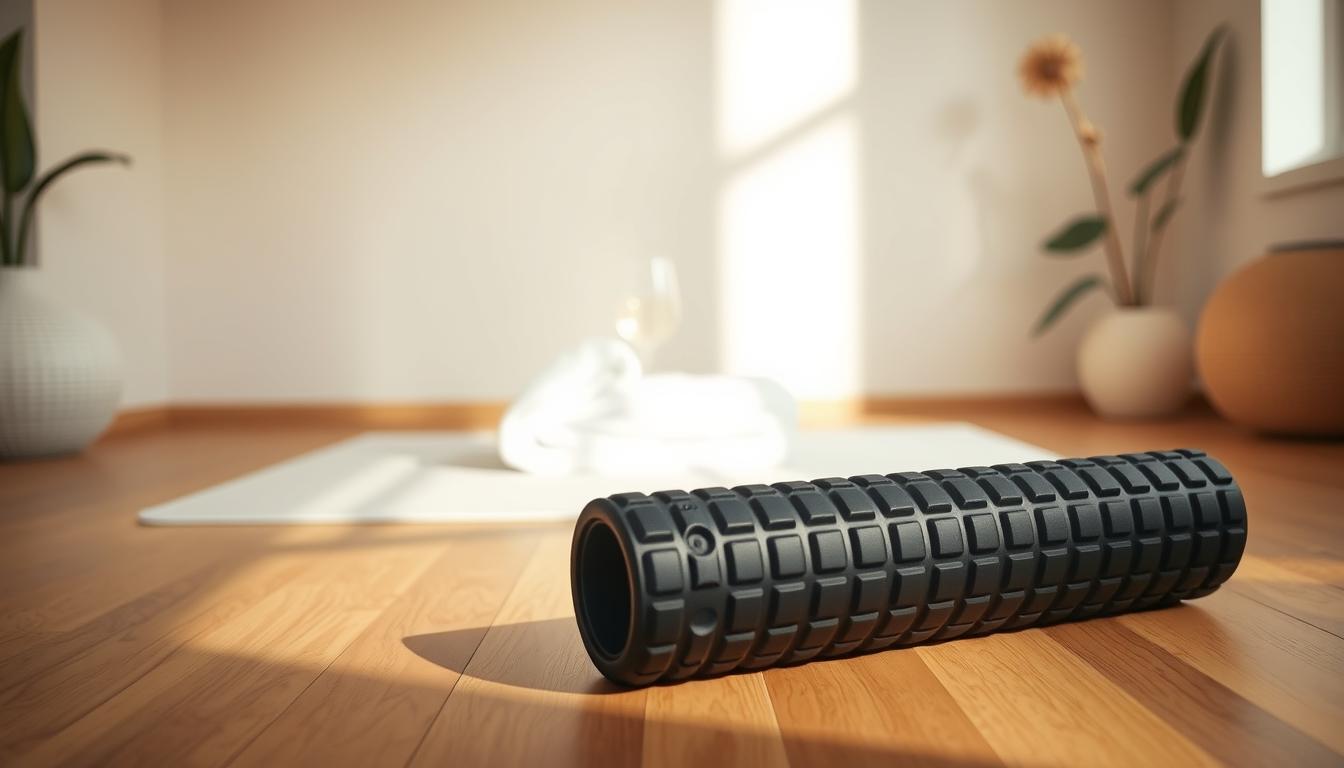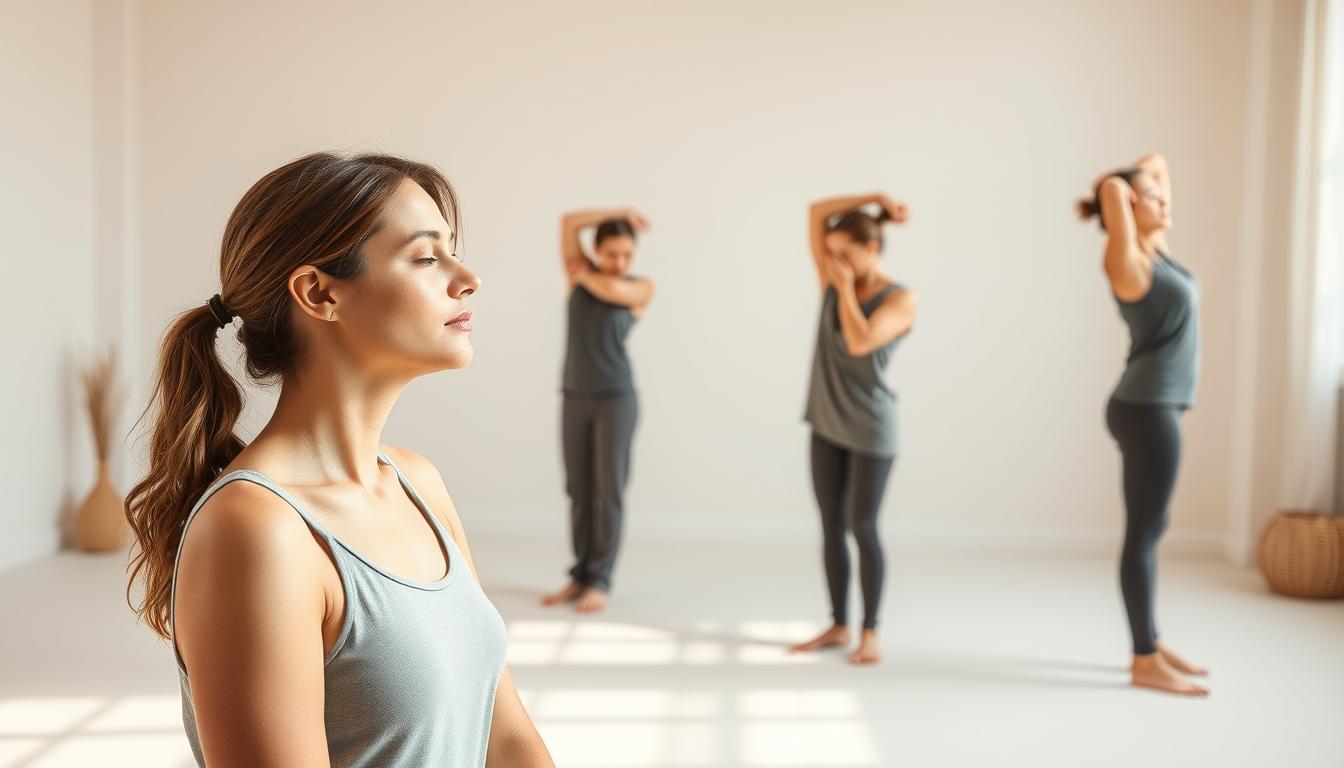In our fast-paced lives, it’s important to take care of neck tension. This discomfort can hurt our daily activities and overall happiness. Resistance bands are a simple way to help.
These bands let you do easy, effective neck exercises. They build muscle strength and make you more flexible. These tools help you quickly ease stress, and you can use them at home.
By doing these exercises, you can stop neck pain. This leads to a life without pain.
Understanding Neck Tension
Neck tension is common and can come from many different things. Knowing why it happens is key to fixing it. There are lots of reasons you might have it, causing pain and tightness.
Common Causes of Neck Tension
Many things can make your neck tense. Here are some top reasons why:
- Prolonged periods of poor posture, including slouching or leaning forward
- High levels of stress, which can lead to muscle tightness
- Lack of movement or exercise, resulting in weakened neck muscles
- Injuries from accidents or sports activities that strain the neck
Impact of Poor Posture on Neck Health
Poor posture is bad for your neck. Looking down at screens or bad sitting habits can hurt. It makes your neck muscles work too hard and causes ongoing tension. Standing or sitting straight helps ease neck tension and is better for you overall.
The Importance of a Strong Neck
A strong neck is important for better physical performance. It supports the head and helps with balance. Having strong neck muscles means you can move better and avoid injuries.
Role of Neck Muscles in Physical Performance
The neck muscles are key but often forgotten in fitness plans. They keep the head steady and help with different exercises. By strengthening the neck, you boost how well your body moves. This benefits athletes and anyone who loves being active.
Neck Strength and Injury Prevention
For preventing injuries, especially from contact sports, a strong neck is crucial. It can better absorb hits, lowering the chances of getting hurt. Physiotherapists say a strong neck also helps you keep a good posture. This reduces injury risks and makes neck strength vital for active people.
Anatomy of the Neck Muscles
The neck has more than 20 muscles. They are split into three groups: anterior, lateral, and posterior. Knowing these groups helps us understand how the neck moves.
Overview of Neck Muscle Groups
The muscles at the front of the neck form the anterior group. They help bend the neck forward. The lateral group is on the sides, allowing the neck to bend and rotate. The posterior muscles are at the back. They help extend the neck and keep it stable during movement. These groups work together to make the neck flexible and strong.
Functions of Neck Muscles
Each muscle in the neck has a special job. For example, flexion is bending the head forward. Extension is moving it back. Rotation lets the head turn side to side. This gives us a wide range of motion. Understanding these muscles helps in creating good exercise and healing plans.
Benefits of Resistance Bands for Neck Training
Resistance bands offer many benefits for those who train their necks. They provide steady resistance which is key for working out muscles well. Using these bands, you can target and make various neck muscles stronger effectively.
Constant Resistance for Optimal Muscle Activation
Resistance bands are great because they give constant tension during exercises. This keeps muscles working hard, which is good for each exercise. They help make the neck strong without harming the joints, unlike regular weights.
Easy Setup and Versatile Use
Setting up resistance bands is easy, so anyone can use them. They’re light and can be used for many different exercises. You can use them at home, the gym, or even when traveling to keep your neck strong and flexible.
Neck Tension Release with Resistance Bands
Resistance bands are popular for easing neck tension. They help with discomfort and stiffness. These bands encourage slow stretching, muscle relaxation, and flexibility. So, they’re great for rehab and growing neck muscles.
Effectiveness of Resistance Bands for Neck Relief
Resistance bands specifically work the neck muscles, which often get stressed from daily activities and bad posture. They offer steady resistance, making muscles work fully during exercises. This approach relieves tension and improves body awareness and posture.
How Resistance Bands Promote Muscle Growth
Using resistance bands for neck exercises is key for muscle growth. They let you adjust resistance for a focused workout. With regular use, they strengthen and stabilize neck muscles. This leads to better neck health and less future pain.
Key Neck Exercises Using Resistance Bands
Using resistance bands for neck exercises can really boost neck strength and make it more flexible. These workouts are great for tackling tense muscles due to sitting too long or bad posture. We’ll go over three important exercises: flexion, extension, and rotation, all aimed at getting your neck in better shape.
Neck Flexion Exercise
Here’s how to do the neck flexion exercise:
- Attach a resistance band at the right height for your head.
- Face away from where the band is tied, holding it with hands on your forehead.
- Gently bend your head down, chin to chest, fighting the band’s pull.
- Go back to start and do this 10-15 times.
Neck Extension Exercise
Here are the steps for the neck extension exercise:
- Tie a resistance band at a point that’s level with your head, facing away.
- Hold the band with both hands behind your head.
- Slowly push your head back against the band, then return to the start.
- Try to do 10-15 reps for better strength.
Neck Rotation Exercise
To do the neck rotation exercise, follow these steps:
- Fix a resistance band at shoulder height and stand sideways to the band’s anchor.
- With arms bent, hold the band in front of you with both hands.
- Turn your head away from the band to feel the stretch, then return to front.
- Repeat this movement 10-15 times on each side.
How to Perform Neck Exercises Safely
Exercising safely is key to preventing injuries while doing neck exercises. A good warm-up readies your neck muscles for the workout. This lowers the chance of hurts. It’s also vital to keep your form right during exercises to get the most out of them.
Warm-Up Techniques Before Exercising
Warm-up techniques are important before starting neck exercises. They get the muscles ready and boost blood flow. Here are some warm-up moves:
- Gentle neck tilts: Slowly tilt the head from side to side.
- Neck rotations: Rotate the head in a circular motion to loosen the muscles.
- Shoulder shrugs: Lift the shoulders toward the ears and release.
These warm-up moves increase flexibility and help ease tension in the neck.
Proper Form and Technique for Maximum Benefit
Keeping the right form is essential with neck exercises. Pay attention to these tips:
- Keep the spine aligned: Don’t twist the neck or bend the back too much.
- Engage core muscles: A solid core helps support the neck.
- Control movements: Go slow to prevent sudden strains.
Following these form guidelines helps you get the most from neck exercises. It also supports long-term health for your muscles and bones.
Incorporating Neck Exercises into Your Routine
Adding neck exercises to your daily workouts is important for strength and flexibility. Deciding how often to do these can really make a difference. Doing them regularly helps your neck muscles get stronger and more flexible.
Frequency and Reps for Optimal Results
For the best neck muscle results, you should:
- 2 to 3 sessions per week
- 8 to 15 repetitions for each exercise
- Allowing a day of rest between sessions for recovery
This plan helps your muscles grow without overdoing it. Change the number of reps as you get stronger and more comfortable.
Combining Neck Exercises with Other Workouts
Mixing neck exercises into your current workout can boost your performance. Here are some tips:
- Include neck exercises as part of your warm-up or cool-down to maximize benefits.
- Integrate them with upper body workouts to improve stability and posture.
- Pair with resistance training for enhanced muscle activation.
By smartly mixing in neck exercises, you create a balanced workout. This leads to better strength, endurance, and less neck pain.
Recommended Resistance Bands for Neck Training
Finding the right resistance bands for neck exercises is crucial. These bands not only provide different levels of resistance but also help focus on certain muscle areas. When picking bands, think about their resistance strength, material, and how easy they are to use. We’ve listed some top choices and brands to help you pick well for your neck exercises.
Choosing the Right Band for Your Needs
Consider your fitness level and what you want to achieve when picking bands. Here’s what to keep in mind:
- Resistance Level: Bands vary from light to heavy. Beginners should start with a lighter band.
- Material Quality: Choose bands made of strong latex or rubber for better resistance and longer life.
- Length and Thickness: Longer and thicker bands are more flexible but need more room. Make sure it fits your workout space.
Brands to Consider for Quality Resistance Bands
There are several trusted brands for high-quality resistance bands. Here are a few to look at:
- TheraBand: Offers a wide range of resistance levels, good for therapy and fitness.
- SPRI: These bands have various resistance levels and are great for building strength.
- WOD Nation: Popular among exercise fans, they offer strong elasticity and last long, perfect for intense workouts.

Additional Mobility Exercises for Neck Relief
Adding resistance band exercises and gentle stretches can really help your neck feel better. These activities help ease tension and make you more flexible. This is especially good for people who sit a lot or do the same motions over and over at work. Doing these exercises will help your neck move better and make you feel more comfortable overall.
Gentle Stretching Techniques
Stretching is key for a healthy neck. Try adding these easy stretches to your day:
- Seated Neck Tilt: While sitting up straight, gently tilt your head toward one shoulder and hold for 15-30 seconds. Repeat on the other side.
- Chin Tucks: While sitting or standing, pull your chin slightly back toward your neck. Hold for a few seconds and release.
- Side Stretch: Reach your arm overhead and gently pull your head towards the opposite side for a deeper stretch.
Other Effective Movements for Occupational Relief
Along with stretching, certain movements aimed at work-related health can decrease neck strain. Try these exercises:
- Shoulder Rolls: Roll your shoulders forward and backward in a circular motion, eight to ten times each way.
- Upper Trapezius Stretch: Grasp the side of your chair with one hand and tilt your head away from the grasp to stretch the upper trapezius muscle.
- Desk-Side Extensions: Stand up and reach your arms overhead, arching your back slightly for a full body stretch.
Conclusion
In this article, we’ve learned how resistance bands can help soothe neck tension. They’re not just for relief; they also make your neck muscles stronger. When you use these bands regularly, your neck gets healthier, and you prevent injuries.
Starting a routine with neck exercises is a powerful way to care for yourself. Using these exercises boosts your neck’s mobility and strength. This leads to a better life. Starting your neck care journey means committing to these exercises. And resistance bands are a great way to start for anyone.



